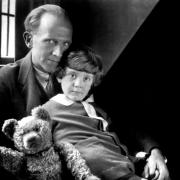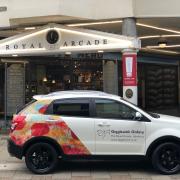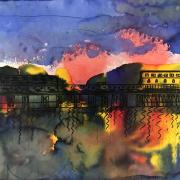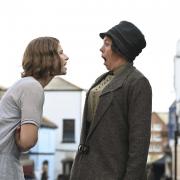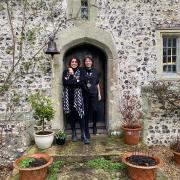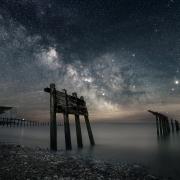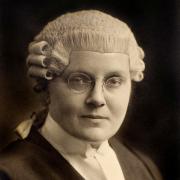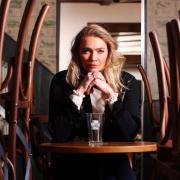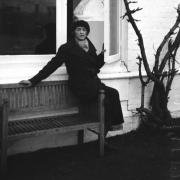They say every picture tells a story, but the odds on photojournalist John Jochimsen living to tell the tale behind more than 120 images published in a remarkable new collection were sometimes slim.
In a career spanning 50 years working for government, Fleet Street and the commercial sector, he gained a reputation for being in the right place at the wrong time – a habit he started in World War II when his journey to school was interrupted by a German fighter plane pursuing him up a Surrey street, spattering the pavement with machine gun fire.
A decade or so later he again found himself the hapless target of anti-British sentiment during a tour of Africa as a photographer with the now defunct Central Office of Information, working on behalf of the Colonial Office. A trigger happy Mao Mao tribesman had him in his sights at the start of the infamously mishandled Kenya uprising against British rule in 1952, for which the UK has only recently agreed to make amends. Clutching his cumbersome camera, he rode shotgun, blasting wildly with a rifle as his driver sped to the next village.
Then there was the time the RAF mistook John for a squadron leader and left him in the cockpit of a Shackleton aircraft from Malta while the crew played cards and worked on a plan to fill a cargo of empty bottles with tax-free Cypriot brandy to sell to the mess on their return. Or the day he was caught in crossfire between British troops and insurgents buried deep in the inky darkness of the Malaysian jungle. “I just wanted to lie on the ground and dig a hole with my nose until the bullets stopped buzzing and they said ‘It’s all right, John, you can get up now,’” he says.
The walls of the small terraced house in Southwater, West Sussex, to which he retired 18 years ago to write, are hung not with happy snaps of family holidays and fuzzy pictures of fondly remembered pets, but with the images he took of Britain at the end of empire and as it built its post-war industrial future. Where most 84 year olds hang school photos of their grandchildren, John has one of the few shots taken of Ethiopian leader Haile Selassie with Winston Churchill on the steps of No 10 Downing Street in 1954. Alongside it, Margaret with Dennis Thatcher pose on the same steps for an official Christmas card in 1982 during which she insisted on getting behind John’s camera to set up the shot herself.
“What she wanted was impossible for me to take and she wouldn’t take no for an answer but I won in the end,” he says.
The images are among thousands of photos John took, initially on glass plates and later on colour 5in x 4in transparencies or 21/4in black and white film over the course of his career. The 120 reproduced in A4 for Through The Lens Of A Photojournalist have an almost three-dimensional quality – a clarity and depth that’s quite astonishing, given the circumstances under which many of them were taken and the technical limitations of equipment and film at the time.
But what makes the random collection so compelling is how it illustrates the huge arc of political, social and industrial change that Britain underwent in the latter half of the 20th century. From the picture of the building of the QE2 to the dawn of a nuclear age with the Queen’s opening of Calder Hall, Cold War-era visits by Russian and American presidents to cricket on a village green and hunting on the Downs, it’s a breathtaking memoir of nationhood.
Born in London in 1929, John had no ambition to follow in the footsteps of his father, a Fleet Street journalist on The Times. So when he was told to get on with choosing a career after the war, John picked filmmaking without much thought or commitment. Marched off to a documentary maker that his father knew, John ended up landing a job as a junior with the Colonial Film Unit at the Ministry of Information, then busily engaged in producing public information movies and news reels, which were dispatched on “cinema vans” to the colonies where they were intended to help keep a restless empire together.
His young cohorts in the film unit at the time included his lifelong pal Bill Williams, who went on to win an Oscar for Gandhi and be nominated for On Golden Pond; Bob Paynter, later cameraman on the Superman movies with Christopher Reeve; and Sydney Samuelson, the son of a silent film director in Sussex, who would eventually head up BAFTA and earn a knighthood for his services to the British film industry.
But the collaborative nature of movie-making didn’t appeal to an independent spirit like John and during two years of national service he began retraining as a stills photographer, eventually returning to the COI as staff man before becoming chief photographer for the UK Atomic Energy Authority. After leaving the UKAEA, he freelanced for the rest of his career, later setting up his own London studio.
He doesn’t regret the path he chose. “Stills appealed to me because you were on your own. In films you had a whole gaggle of people around you. But you were alone in Fleet Street. Everything was down to you,” he says.
One of his earliest jobs as a rookie freelancer in the Fifties was for a Fleet Street picture agency with the unlikely title of Planet News. He was assigned to cover a party thrown by the American millionaire J Paul Getty at Sutton Place near Guildford, but as the other photographers drifted away with glamour shots of Hollywood starlets, John hung back.
“I thought to myself, there’s a big swimming pool here and someone’s going to be thrown into it. So I sat down at a table and waited. Sure enough at 2am it happened. I got three pictures. The one of the bloke coming down in the water went in the Evening News the next day.”
The post-war partying and optimism at home was in sharp contrast to the dispiriting chaos he was soon to witness in Africa. The official photographer covering Princess Elizabeth and the Duke of Edinburgh’s honeymoon tour, he was one of the first to see the new queen after news of her father King George VI’s death reached the couple in Kenya. And, as she returned home to look after the affairs of state, John came face to face with the disintegrating empire she’d inherited, travelling between colonial outposts and documenting the fragile peace, which occasionally erupted into outright war, on behalf of the government.
He confronted it all with a highly developed sense of the absurd, faithfully recording what he was asked to and maintaining a professional disinterest in the politics.
“In the Sahara, there were no road maps. I was told to follow the beer bottles – they weren’t supposed to drink alcohol, of course, but they all did and threw the bottles off the camels. So that’s what I did. You ended up with some colonial district officer, who lived on his own in the middle of nowhere and they were all as peculiar as coots. I thought the first one was fine, until we were having drinks and the crickets started up. He brought out a bull whip and brought it down, bang, bang, bang until they shut up. Thirty seconds later, they started up again and so it continued.”.
The colour transparency film he used on the tour was to become the preferred format for news, commercial and advertising photography and some of the pictures he tracked down to various archives for the book were among the first trannies to find their way into print. He continued working with the format up until the Nineties when the industry migrated to digital imaging.
By that time, John and his wife Chris, now with four children, had moved to a farm at Slinfold near Horsham where, with customary enthusiasm and dogged determination, he embraced the rural life, building a flock of 400 ewes and 14 rams, while 45 chickens grew to a sizeable business of 5,000 with a free range egg delivery round. He dovetailed farming and photography until, with Chris’s death in 1996, he gave them both up, selling the farm and the cameras that had witnessed so much.
“I have a little happy snap camera that I must have done half a dozen pictures on and it sits upstairs gathering dust,” he says. “Sometimes I wish I could have a decent camera again, but I don’t think a professional photographer could see it as a hobby after 50 years.”
***
Through The Lens Of A Photojournalist, £24.99 , is published by MX Publishing. It is available from Amazon or good bookshops and is a follow-up to John’s autobiography 80 Years Gone In A Flash
--------------------------------------------------
Read on
Guide to shopping organic in SussexMichael Simkins on growing up in Brighton, witnessing a near-catastrophe on stage and his career as a writer




